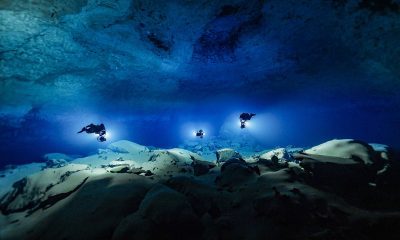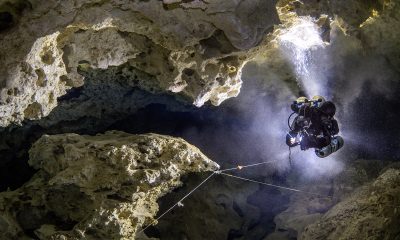Cave
EXPLORING AND DOCUMENTING SA CONCA ‘E LOCOLI CAVE

Text by Andrea Marassich. Photos courtesy of Phreatic. Header image: An inflatable (aka The love boat) is used to facilitate transportation of diving gear through the lakes.
Locoli cave is an amazing and challenging spring in the wilderness of Montalbo, Sardinia. It took me three years to set up the project, but it was all worth it. After all, David Rhea taught me that, “Slow is smooth, smooth is fast.”
I’m Andrea Marassich. I began exploring underwater caves in 2003, and I have taken part in cave exploration missions all around the world. In 2010, I fell in love with the powerful, majestic cave systems of Northern Sardinia, Italy. As a result, in 2014, I founded a nonprofit association, Phreatic, which collaborates with scientists and researchers in geology, paleontology, and earth sciences to study and document these unique environments.
In 2019, I presented at Icnussa, the international speleology meeting in Sardinia, and spoke about Phreatic projects. During the event, a local caving club offered to carry diving gear to the first sump of a cave I had never heard of: Sa Conca ‘e Locoli. I dove with fellow GUE instructor Stefano Gualtieri, and it was love at first sight. During the dive, I realized that I wanted to get back for more survey and exploration.
The Environment
“Locoli” is a temporary spring (active after rainfall and during certain seasons) located into Montalbo limestone massif, and is included in the UNESCO MaB (Man and the Biosphere) reserve of Tepilora, Rio Posada e Montalbo.

This Sardinian version of the Dolomites Alps, with its white rocks, looks out onto 25 km/16 miles of coastline. The silver ridge of Montalbo features evocative itineraries: historic trails for coal merchants and shepherds, archaeological sites, holm oak forests, and Mediterranean scrub (populated with mouflon, the golden eagle, and the red-billed chough). The peak presents doline valleys, chasms, underground rivers, as well as caves prehistorically inhabited by the Nuragic civilization. Archaeologists uncovered iron weapons in Bona Fraule, Gane ‘e Gortoe is rich in limestone concretions, Sa Conca ‘e Locoli is eroded by the fierceness of the water, and Sa Prejone ‘e ‘Orcu is a cave-sanctuary.
Sa Conca’e Locoli
Locoli spring, which can submerge the whole valley during winter flooding, forms the entrance to the massive cave system hidden beneath Montalbo. The entrance cavern leads to a series of crystal-clear, freshwater lakes, and though the access is not technically complex, it requires the use of ropes through multiple changes of elevation, while the decorations and speleothems inside alternate with the smooth rocks levigated by water passage.
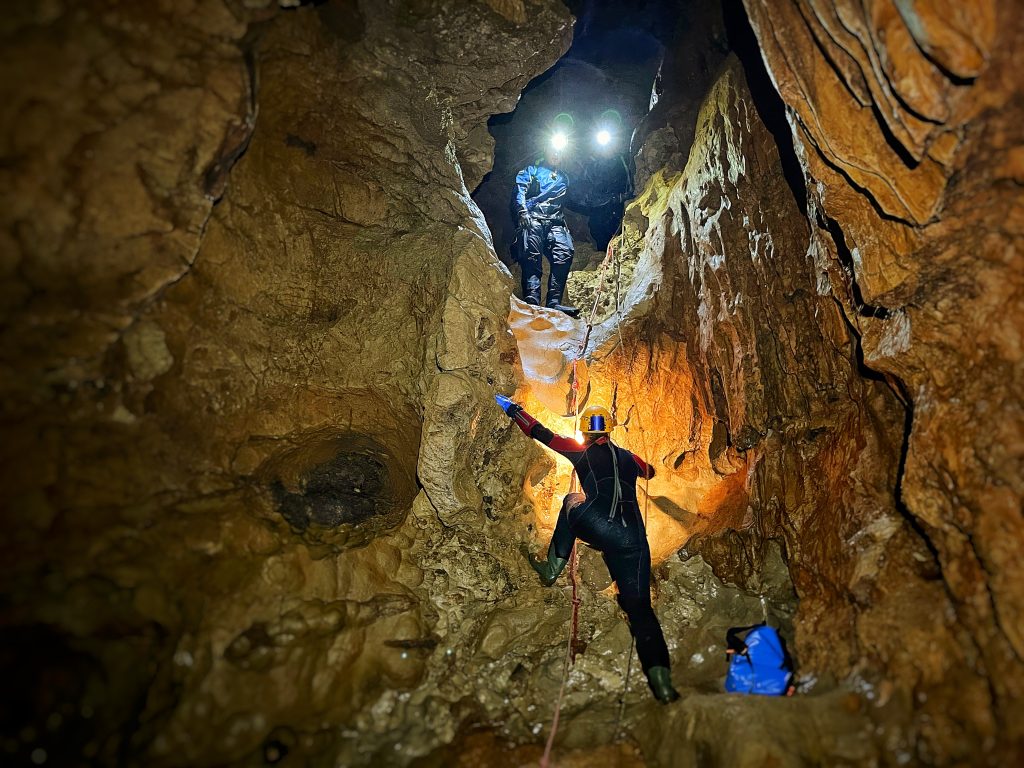
After the lakes, the cave splits in two. The south passage leads to a shallow sump looping back downstream and connecting to a minor spring in the valley. The north passage goes through a series of changes in elevation, which require the use of ropes, and leads to a wide passage that provides access to the surface of Sump 1.
This is the entrance gate to a series of huge flooded passages of breathtaking dimensions with obvious signs of a huge aquifer. The first sump is not particularly long or deep at 250 m/820 ft long with a maximum depth of 23 m/76 ft, but it leads to a very important second split. Here the subterranean river flows downstream toward the village of Siniscola and the Fruncu ‘e Oche spring, while on the upstream side it heads toward four other challenging sumps and dry areas.
In the island of Sardinia, Sump 3 is the deepest, reaching 90 m/295 ft.
The last exploration dive carried out in 2009 by Rick Stanton led to a collapse in Sump 5; consequently, the present survey only covers the first two sumps.
The Project
In 2020, I organized the first scouting mission of the deeper sumps, together with Jan Medenwaldt. COVID-19 travel limitations presented difficulties in gathering a bigger team.
In 2021, finally, we managed to organize a three-week campaign encompassing both survey and photogrammetry. The exploration of the system is particularly complex for a variety of reasons. First, the underwater portion is accessible after a relatively long dry passage, one in which cavers and cave divers must carry all their heavy gear. Subsequently, the series of sumps is difficult from a technical point of view, as the diving profiles involve serious exposures in Sump 3 and 5.
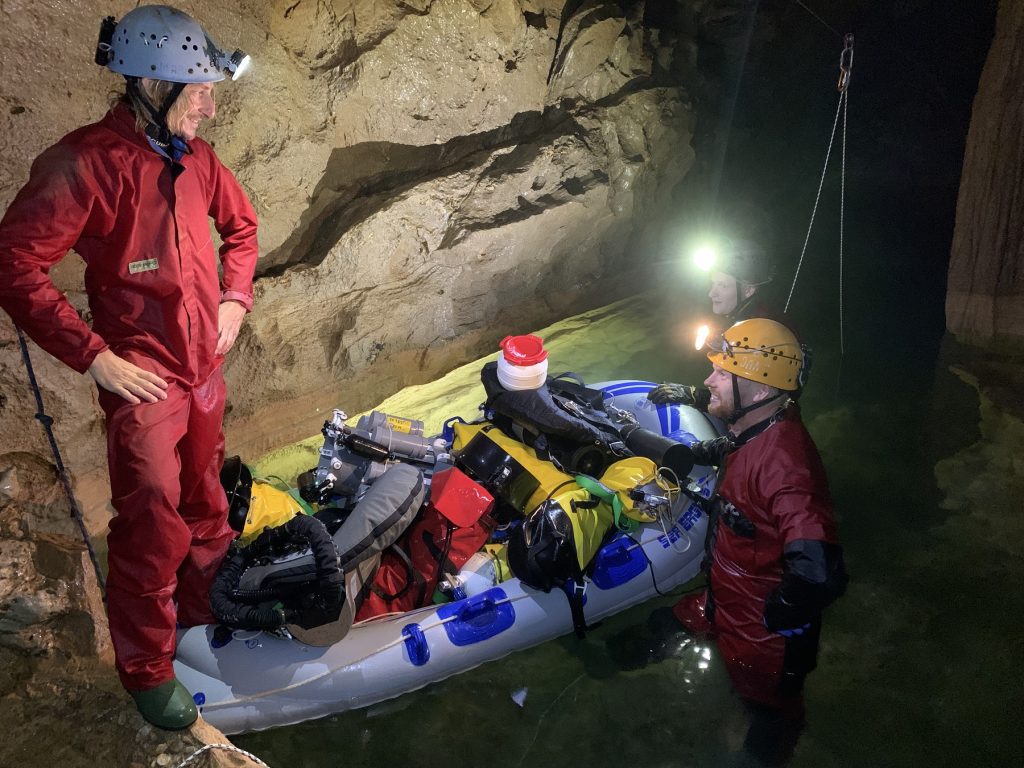
In order to complete the working goals connected with survey, mapping, photo/video, and research tasks, divers needed to extend their diving time and elected to stay inside the cave and set up a bivouac; entering the cave with dry tubes and bivouac gear without knowing where to establish the camp was risky. We found a new dry section between Sump 3 and 4, which proved to be ideal to bivouac and minimize the decompression risks connected with the profile.
The main challenge is dealing with the geology of the cave, one that presents multiple elevation changes to move from one sump to the next. Sump 3 is the most demanding of the five underwater galleries, as the cave drops initially to 45 m/148 ft deep, then rises to 15 m/49 ft, drops to 90 m/295 ft, ascends again to 45 m/148 ft, and drops again to 65 m/213 ft before the final ascent.
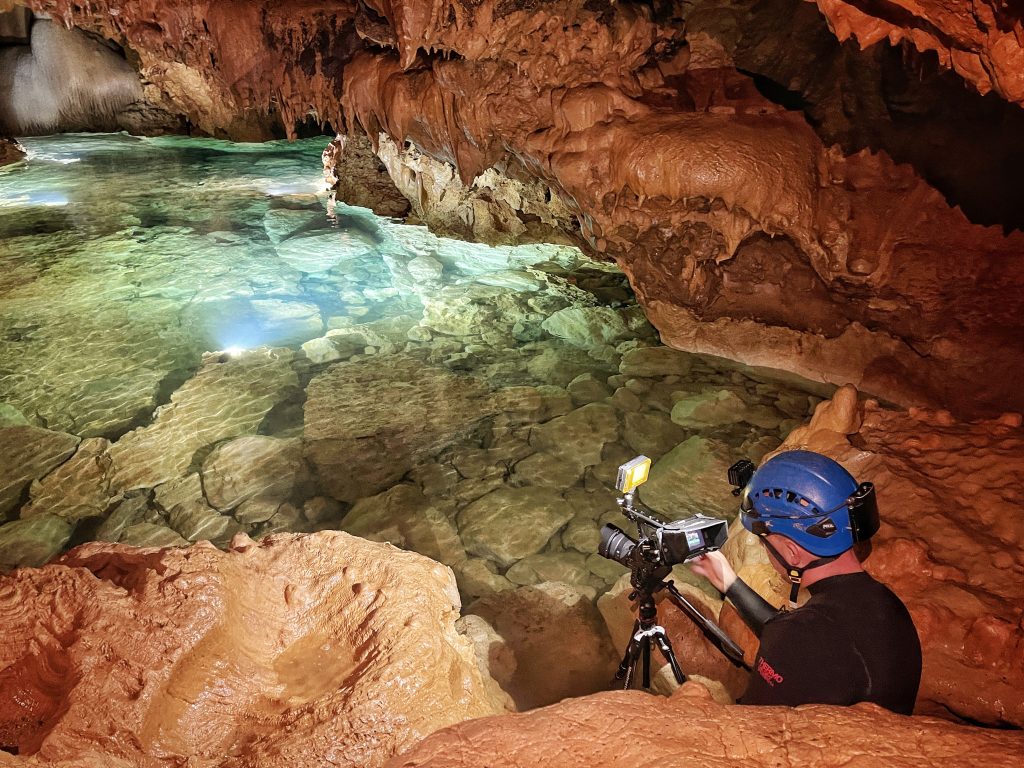
The exploration efforts are now divided in two areas: the newly discovered dry section between Sump 3 and Sump 4, featuring massive rooms and high chimneys that potentially connect with a fossil gallery above, and Sump 5, whose exploration stopped at a depth of 50 m/164 ft and needs further investigation.
We are already working on new project sessions for summer 2022.
Considering the importance of the karst system of Montalbo and its water reservoirs, the UNESCO MaB reserve decided to support our project, specifically in relation to our documentation and conservation efforts. We also received the sponsorship of the Italian Speleological Society and are now searching for more partners.
The main objectives will be:
- Completing the survey of the upstream section up to Sump 5. To perform this task, we will use the SUEX DRIVe and mapping devices combined with MNemo.
- Creating a documentary featuring the most beautiful passages of the cave with the help of an expert photogrammeter and videographer.
- Improving public awareness about caves and karst in partnership with the International Year of Karst and Cave initiative provided by the International Union of Speleology.
Citizen Science
Phreatic believes in the power of Citizen Science. All our projects and missions rely upon the crucial involvement of skilled, specially trained individuals. The Sa Conca ‘e Locoli cave project involves a number of local and foreign volunteers with various sets of competences. Many thanks to Speleo Club Nuorese for the support in the dry portions of the cave, and to all the Phreatic volunteers who joined us in 2021 including Jan Medenwaldt, Peter Brandt, Sven Bertelmann, Keith Kreitner, Laura Marroni, Elke Riedl, and Irene Homberger.

Collaborations and Partnerships
Phreatic can count on a long-term partnership with SUEX, a world leader in high-performance underwater vehicles designed for long-range technical and professional diving.
The Locoli project operates under the supervision of the geologist Dr. Francesco Murgia, author of multiple scientific publications on the areas of Montalbo and Supramonte.
For more information see: Phreatic: Citizen Science and Groundwater Research. Email contact: [email protected]



























